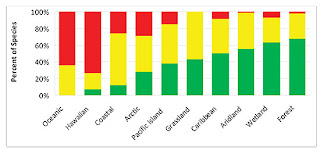How many Alaskans enjoy seeing birds? I'm not sure that has ever been measured accurately, but I suspect that an analysis of winter bird seed sales or an attitudinal survey of the general population would likely yield surprising results - for example, I attended a bird rescue fundraiser in Wasilla last year and was amazed by the constituency that all species of birds have there - and that was not just due to the impressive influence of the host, the irrepressible and flamboyant self-professed bird lover, Mr Whitekeys!
I have also participated in various bird counts in Alaska and been amazed by the lengths and heights birders will go to to add to their life lists... as my Yorkshire mate Dave would say - its amazing how far twitchers will go!
Based on this new report released last week, it looks like birders will have to go to even greater lengths to enjoy the lesser numbers and diversity of birds in the USA as habitats and climate change. The new report was made public by Interior Secretary Ken Salazar - The State of the Birds: 2010 Report on Climate Change (http://www.stateofthebirds.org/) makes alarming reading. The report, a collaboration of the U.S. Fish and Wildlife Service and experts from the nation’s leading conservation and avifauna research organizations, shows that climate changes will have (as the graph below indicates) an increasingly disruptive effect on bird species in all habitats, with oceanic and Hawaiian birds in greatest peril.
Relative Vulnerability by Habitat
(red = high, yellow = medium, green = low)
This graph is obviously somewhat generalized and I am still puzzled why arctic and alpine species were lumped together, but the overall trends are still very disturbing, particularly in relation to species we work with on education and research programs here at the Alaska SeaLife Center.
For example, the report notes that:
• Oceanic birds are among the most vulnerable species because they don’t raise many young each year; they face challenges from a rapidly changing marine ecosystem; and they nest on islands that may be flooded as sea levels rise. All 67 oceanic bird species, such as petrels and albatrosses, are among the most vulnerable birds on Earth to climate change.
• For bird species that are already of conservation concern such as the golden-cheeked warbler, whooping crane, and spectacled eider, the added vulnerability to climate change may hasten declines or prevent recovery.
Our pioneeering work with the recovery team responsible for Steller's Eider (see http://ecos.fws.gov/docs/recovery_plans/2002/020930b.pdf) is indicative of the level of effort that will need to be mounted more widely and quickly for a host of bird species if the current rate of climate change continues.
This new report will be very helpful in identifying both immediate priority species and overall research, adaptation and recovery research needs as the SeaLife Center moves forward with our 2020 Strategic Plan . I encourage all staff and partners to read it and provide sugestions to our avian research and education team on how we might play a more effective role in adaptation and management efforts.



No comments:
Post a Comment